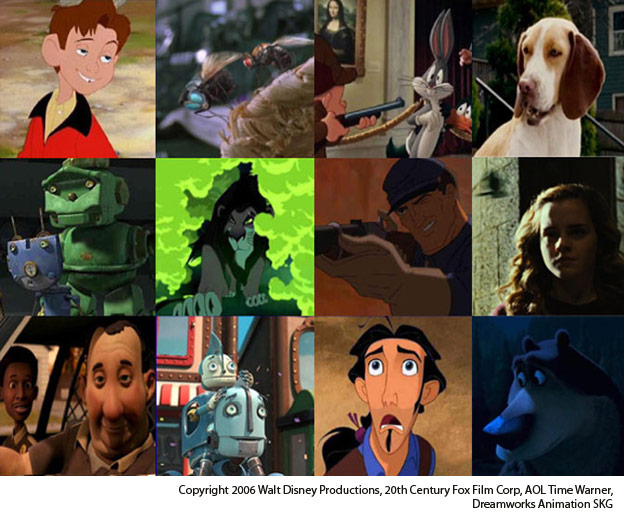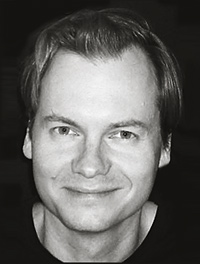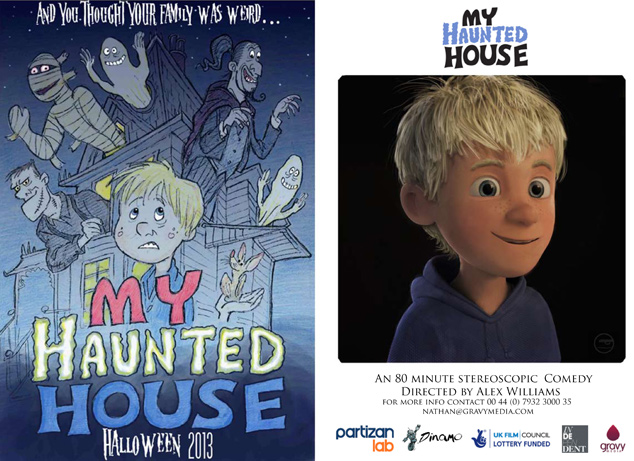Interview: Animator Alex Williams (Who Framed Roger Rabbit, Lion King, Iron Giant)
Alex Williams has been involved in animation since the start of the ‘animation renaissance’ of the mid 1980s, which most people credit to ‘Who Framed Roger Rabbit’ a film in which his father Richard directed the animation. Originally wishing to become a barrister Alex’s career took him away from a career in law and through to Hollywood to work on some of the greats such as ‘The Lion King’, ‘Pocahontas’ and ‘The Iron Giant’ before he turned his hand to CGI and worked on films such as ‘Robots’
 A
A
s part of a British networking event held at Annecy Alex Williams gave a presentation addressing the tricky task of gaining funding for a feature film as well as sharing his ideas for a feature that he presented at ‘Cartoon Movie’ this last year. I managed to catch up with Alex to ask him a few questions about his life in animation, giving up a career as a barrister for animation and ‘My Haunted House’ his animated feature film idea.
You trained and worked as a barrister – what made you give it up and become and animator?
I had already worked as an animator on several films before I took up lawyering, including The Lion King, back in 1993. As it turned out I didn’t last more than a couple of years in law. I started practice at the Bar in the mid-90s when the animation business started seriously booming in Hollywood, which proved a major distraction. In the end I was lured out to Los Angeles in 1996 by Warner Bros, who were just setting up their new feature animation division. Therefore, I abandoned law and went back to my drawing board; which turned out to be lucky because I got to animate on Brad Bird’s wonderful Iron Giant – one of the best films I have had the good fortune to work on.
It’s kind of you to suggest I have conquered them but I don’t really think I have – there is always so much to learn. I just try to turn my hand to whatever needs doing at the time and stick with it in a kind of dogged and persistent way. The switch from 2D to 3D animation was really in the end born of necessity. I came pretty late to CG and I fought against it for far too long. However, as artists we have to embrace new technology, even if we don’t like it. Technology is driving the business right now and we must learn to adapt to it, or else get left behind. Especially in visual effects work, the tools are changing all the time and every production house is constantly trying to gain a technical edge over the others. Nowadays a good working knowledge of Maya, Photoshop, AfterEffects and Premiere (or one of their competitors) is pretty much essential.
 You started work with your father’s company at the very start of the “animation renaissance”. Did you get a chance to work with any of the greats that assisted during the production of Roger Rabbit? Or during the production of ‘The Thief and the Cobbler’?
You started work with your father’s company at the very start of the “animation renaissance”. Did you get a chance to work with any of the greats that assisted during the production of Roger Rabbit? Or during the production of ‘The Thief and the Cobbler’?
Both films were very inspiring to work on. On The Thief I got to work on many old archived scenes roughed out by two great animation legends – Art Babbit and Ken Harris. Both animators were long dead by the time I inherited their shots (though I had met them as a child), and I began work in effect as their assistant animator, going over their drawings, tidying them up and adding the finishing touches. It was wonderful training. Actually, I don’t think I realised at the time how lucky I was.
Can British animation still hold its head up high with the rest of the world? Given the state of the industry and the lack of funding the we get?
It’s true that we don’t get much government funding, but we do have a very healthy industry nonetheless, especially in visual effects work. London has at least four companies with an international reputation, and they have created a kind of critical mass for VFX work in Soho. I don’t see that changing any time soon, despite intense foreign competition. Also Bristol has become a global hub – Aardman is without doubt a world leader, with a unique style. Although, our 3D training could definitely improve – we need to be giving students the kind of intensive artistic and technical immersion that they get at Gobelins in France or The Animation Workshop in Denmark. The business is a marriage of art and technology now, and we ignore that at our peril. I teach an animation course at Escape Studios in London where we work hard to give the students the latest 3D training that is directly relevant to the needs of the industry.
Can you explain the process of getting a feature film made today?
The key problem of course is raising finance. You can’t just go to the bank and get a loan, you will need investors and partners, few of whom will likely take more than say 20% of the risk. So you have to pitch; to do that you need a great idea, ideally a high-concept “What if?” idea that will get your project noticed. In the UK there is limited finance but it is possible to involve other European partners, and through them find foreign co-production financing. I highly recommend the Cartoon Movie forum in Lyon; it’s a kind of “Dragon’s Den” for animated films and it takes place in March every year. The deadline for submission of ideas is November. I brought my project “My Haunted House” to the market at Cartoon Movie this past March and we had a wonderful response; lots of interest which we are currently building on.
What is your involvement with South-West Screen?
South-West screen have been wonderful at supporting Gravy Media’s projects (Gravy is producing My Haunted House) and have been a huge source of encouragement and support. They asked me to come and speak at their Annecy event and I could hardly refuse.
What are you working on at the moment?
Many different projects, but much of my time now is spent working on my independent movie “My Haunted House”, a feature film for theatrical release at Halloween in 2013. It’s a story about a boy, a perfectly normal 12 year old child who just happens to live in a haunted house. His family are ghouls and ghosts – he’s the only one who’s normal. It’s a story about wanting to fit – and wishing your family were different, more normal like the other children. So, hopefully, a pretty universal story, really. We’re co-producing with Denmark and Germany and we are in the process of putting the final budget together and locking down the finance structure. It’s hard work but it’s thrilling to be working on our own feature film.


